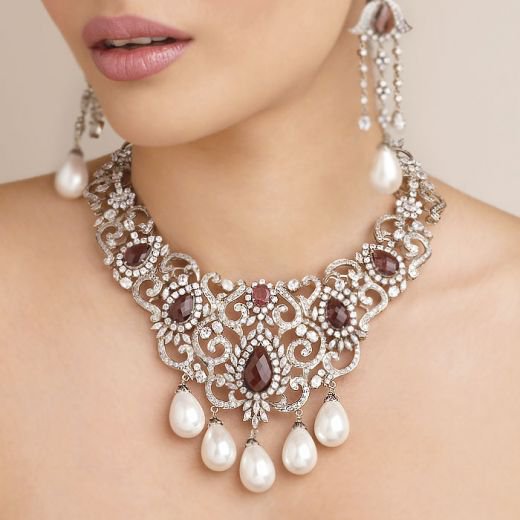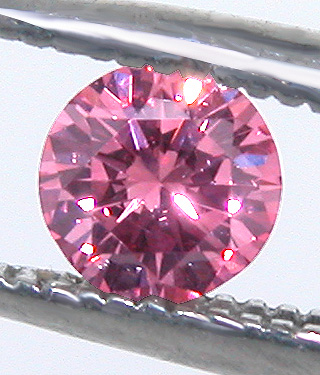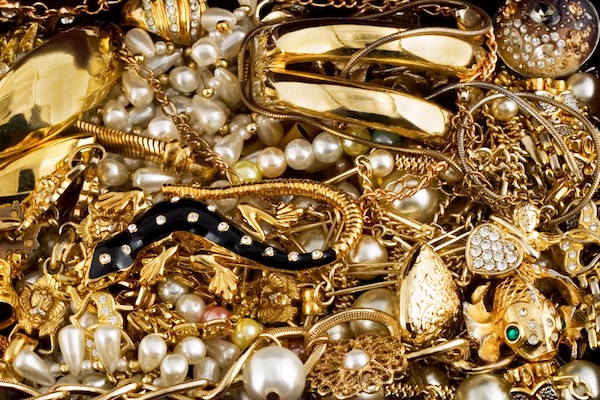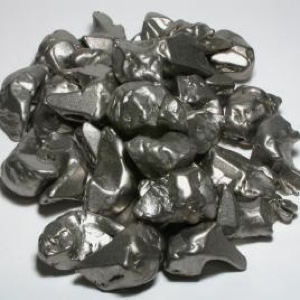AURORA BOREALIS
A coating on diamantes and crystal beads to create an iridescent effect. The name is coined from the Northern Lights.
BAGUETTE
A stone cut in a narrow rectangular shape.
BAKELITE
A phenolic resin, which is an early form of plastic. Dr Leo Baekeland patented it in 1909. A popular material in the 1930’s to create bright, colourful and whimsical jewellery, which is highly collected today.
BALE
A loop attached to a pendant or brooch in which to thread a chain or ribbon.
BAROQUE
Is associated with irregularly shaped pearls/faux pearls such as the ones favoured by Miriam Haskell.
BASE METAL
A non-precious metal/alloy, such as brass and copper
BEZEL SETTING
Also known as a mille setting. The setting encircles the stone and is folded/burnished over the edge securing the stone.
BOG OAK
Fossilized peat, which mainly comes from Ireland. Was used to create less expensive mourning jewellery and items.
BRILLIANT
A round cut stone, the modern cut brilliant cut stones have 58 facets.
BRIOLETTE
A faceted drop with a pointed top and rounded bottom.
CABOCHON
A dome shaped stone with a flat base and smooth, unfaceted, surface.
C CATCH
This type of clasp is associated with jewellery from the Victorian period. It is simple in its construction in that the metal is curved in a C shape.
CAP
A cone shaped cup, usually decorative, which encases the top of a bead or pearl drop
CAMEO
Intricately carved shells, usually depicting a classical scene or a profile.
They also are carved in Jet, Ivory and lava.
CELLULOID
Another early form of plastic, patented in 1869. It was a less expensive material used to make jewellery and hair decorations, instead of tortoiseshell and horn. It is quite fragile and highly flammable. These pieces are highly collectible today.
CHANNEL SETTING
Stones are set in a channel of metal, which is then folded over the stones to secure them
CHARMS
Originally worn for protection to ward off evil spirits and ill health. In the forties and fifties it became the fashion to wear charms suspended from a bracelet or necklace. These would often be given to mark special or historical events in ones lifetime.
CHATELAINE
Originally, a chain worn suspended from the waist, which held objects used by the wearer, often the housekeeper.
CLAMPER
A style of bracelet, which has been hinged at the back, it relies on the force of the hinge to hold the bracelet closed.
CHOKER
A short necklace, worn high on the neck, which is also known as a dog collar, favoured by Princess Alexandra at the turn of last century.
CLAW SETTING
A setting with four or more claws bent over the stone to hold it in place. The Americans refer to this type of setting as – prong.
CLIP
There are various types, but here it refers to dress or shoe clips. The clips are held in place by spring pressure but may also have teeth or prongs.
Clip fittings on earrings are for non pierced ears (although can be worn by those with pierced ears) these were patented around 1934.
CONFETTI LUCITE
is a transparent form of Lucite which has been embedded with small pieces of material, such as Lucite chips, glitter, diamantes or seashells.
COSTUME JEWELLERY
A term thought to have been coined by Flo Ziegfeld or Coco Chanel, it really only came into use in the 1930’s, to denote jewellery made from non-precious materials.
DEPOSE
Usually found on the reverse of jewellery made in France
DIAMANTE
Also known as rhinestones in America, strass in Germany and Austria. It is a foiled backed stone made to resemble precious gemstones.
DOG COLLAR
Also known as a choker, a necklace worn high on the neck,
very popular with Princess Alexandra in the Edwardian period.
DROP
A small ornament, such as a bead or pearl, suspended from a necklace or earrings.
DUETTE CLIP
This is actually a CORO trademark but commonly refers to all pieces of its type. Two hinged dress or fur clips attached to a frame can be worn as a brooch or separately. Popular in the 1930/40’s
ELECTROPLATING
A method used to attach a thin layer of precious metal onto base metal using an electronic device.
ENAMEL
Coloured glass or glaze fused onto a metal base. Some enamels are poured into a metal frame allowing the light to shine through, known as plique de jour. The famous Rene Lalique favoured enamel work in his fabulous art nouveau pieces. An alternative method of enameling is to pour the molten glass over a design etched into the metal back, to create a pattern in the enamel, known as guilloche.
ENGRAVING
A sharp tool is used to cut a pattern or initials into metal or stones.
EN TREMBLANT
A component of the piece of jewellery is set on a spring which enables it to “bob” when on. Christian Dior used this in his designs. These pieces are highly collectible today, as the springs would become damaged over time.
ETCHING
Is created by cutting a design into metal or a stone and then submerging the piece into acid.
FACET
A small flat surface cut into stone or glass, which refracts light to enhance the brilliance of the stone.
FIGURAL
Jewellery created with a naturalistic theme, such as animals, insects, birds, objects and people.
FILIGREE
Fine strands of metal, either precious or non-precious, twisted and manipulated into intricate lacy patterns.
FINDINGS
Functional parts of jewellery such as earrings fittings, clasps, metal links, caps and settings.
FOIL
A reflective metal coating on the reverse of a diamante to enhance its brilliance.
GALALITH
An early form of plastic first made in 1897. It is made from natural proteins from organic substances such as milk. It became popular as an ivory substitute, known as ivorine.
GIRANDOLE
A type of drop earring with three or more pendants often found in the court of Marie Antoinette and later reproduced by Kenneth J Lane.
GOLD FILLED
This is mainly an American term, which is similar to gold plating. It is a sandwich of metal with two thin layers of precious metal on either side.
GUILLOCHE
Guilloche is French for “engine-turning”, it is a method of mechanical cutting of lines on metal to create a design. Because the pattern is engraved, the reflection of light through the over casting of transparent enamel is enhanced, and its brilliance can be seen as the piece is moved from side to side. The best known, but not the first, artist using this technique was Carl Faberge.
GUTTA PERCHA
Popular for jewellery making in the 1800’s. It is a natural latex substance obtained from the bark of the Malaysian Palaquium tree.
HINGED FITTINGS
Similar to the hook fitting but with a hinged back for added security
HOOK FITTINGS
Also known as loop or ear wires. A simple fitting made of bent metal.
This type of fitting was used in the Victorian period.
INTAGLIO
An image carved into the reverse of stone and viewed from the other side.
Like a cameo in reverse.
JAPANNED
Metal objects/settings are painted/enamelled black, originally used for mourning pieces later used to blacken
JAPANESE CELLULOID
Most pieces are marked Japan have been made after the Second World War. Generally
Made of softly coloured moulded plastics.
JET
The most famous is the jet found in Whitby. It is fossilized wood
with a rich black colour, which never fades. It was used
extensively in the Victorian period to make mourning jewellery.
LARIAT
A single stranded necklace with open ends, usually decorated with tassels, which are looped or knotted.
LAVALLIERE
These pieces are also known as negligees. A single drop suspended from a chain.
LOCKET
A pendant made in two halves which are hinged, created to encase a picture or a lock of hair of a loved one. These were very popular with the sentimental Victorians.
LUCITE
A thermoplastic first introduced in 1937. In it’s original form it is colourless but can be tinted to create an array of colours.
MARCASITE
Also known as white iron pyrite. In jewellery making it is faceted to imitate diamonds.
MARQUIS CUT
A stone cut in an elongated shape with pointed ends. The Americans call this
a navette.
MATINEE
A single stranded necklace (such as a rope of pearls) measuring 30 to 35 inches.
MILLEFIORI
A glasswork technique, which produces distinctive decorative patterns on glassware, using glass cane or rods, with multicoloured patterns, which are viewable only from the cut ends of the cane. Millefiori beads are made of plain glass bead cores, thin slices of cut cane are pressed into the bead surface, forming mosaic-like patterns, while the glass is still hot. The term millefiori is a combination of the Italian words “mille” (thousand) and “fiori” (flowers), roughly translating into multi floral.
NIELLO
Metal is dipped into acid to turn it a black, and then a pattern is etched into the surface.
OPERA
A single stranded necklace (such as a rope of Pearls) measuring 48 to 90
inches.
PAPIER MACHE
Layers of paper and glue are dried or baked in an Oven to create many
different types of objects including jewellery. The Venetians use this to make
their carnival masks.
PARURE
A matching suite of jewellery, consisting of A necklace, bracelet, earrings and
a brooch. Lesser sets are called a demi-parure.
PATE de VERRE
An opaque dense glass, which is made using crushed glass, combined with metal oxides. It can be coloured and moulded, popular in Czechoslovakian jewellery.
PAVE
Small stones, diamonds or diamantes, set into metal without claws.
PASTE
An imitation gemstone. The name derives from Italy as the molten glass
looked liked pasta dough.
PEAR SHAPED
A pear or tear shaped stone has a single pointed end and a rounded bottom.
PENDANT
An ornament suspended from a chain or necklace. This is usually moveable but can also be fixed.
PINCHBECK
The Victorians used this alloy to imitate yellow gold. Thought to have been created by Christopher Pinchbeck, who was an English watchmaker in the early 1700’s
PLIQUE de JOUR
Popular in the Art Nouveau period and used by famous designers such as Lalique. The enamel is placed over an open setting allowing the light to shine through.
REPOUSSE
A design, which has been hammered out from the reverse.
RHINESTONE
Also known as diamante. It is a foiled backed stone made to resemble precious gemstones. The Europeans use this term for what is also known as a rainbow crystal.
RHODIUM
A white metallic coating derived from platinum, which is applied, to base or precious metals using an electroplating device.
RONDELLES
Small round spacer beads chanel set with diamantes.
ROSE MONTEES
Flat back faceted diamantes/rhinestones. This type of stone is often found in
designs by Miriam Haskell, Robert and De Mario in the 1940/50’s.
SAFETY CLASP
This is the type of clasp that we are used to today, it has a centerpiece which swivels round to lock the pin into position. Patented around 1910.
SAUTOIR
This type of necklace was popular in the 1920/30’s, a long necklace of chain, beads or pearls, terminating with a tassel.
SCATTER PINS
Small brooches usually worn in a cluster, such as stars, flowers, birds and insects.
SCREW FITTINGS
Earring fittings, which are the pre cursor to clips. They are for non-pierced ears (but can just as easily be worn if the ears are pierced). They were patented in 1894
TASSELS
A pendant with free hanging components such as chains, beads or silk.
THERMOPLASTIC
A form of plastic, like Lucite and celluloid, which can be melted and reformed.
THERMOSET
A form of plastic which cannot be reformed when heated.
TOLEDO WEAR
a type of decoration used in the making of Swords in Toledo in Spain, in the later half of the fifteenth century. The artisans learned and brought the technology to the Iberian peninsula from the famous city Damascus, in Syria, hence the other commonly used name – Damascene. Damascening is the application of interlacing gold on iron or steel to produce beautiful decorative designs.
TORSADE
A necklace consisting of multiple strands of beads, pearls or chains, which can be twisted together.
TROMBONE CLASP
An early form of clasp, which has a plunger type fitting to lock the pin into position. Patented around 1850.
VULCANITE
A hardened rubber, which was made combining India rubber with sulphur and used to imitate jet and coral. Charles Goodyear patented it in 1844.











